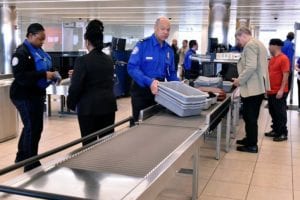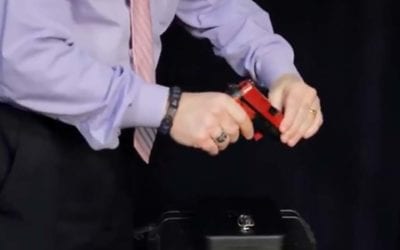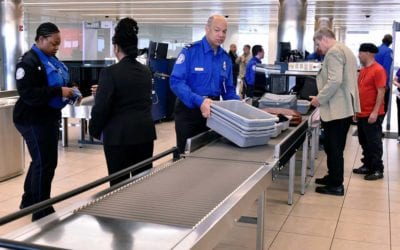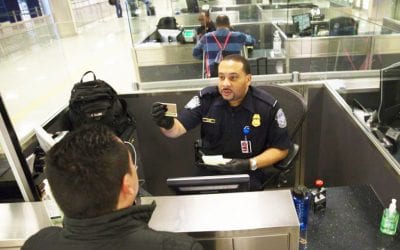New TSA rules are nationwide by mid-June in response to COVID-19

TSA has already begun the implementation of these changes. As a result, more changes will be implemented at airport checkpoints nationwide by mid-June. The steady growth of travelers coming through airport checkpoints has already been registered by TSA.
“In the interest of TSA frontline workers and traveler health, TSA is committed to making prudent changes to our screening processes to limit physical contact and increase the physical distance as much as possible,” said TSA Administrator David Pekoske. “We continue to evaluate our security measures with an eye towards making smart, timely decisions benefiting health and safety, as well as the traveler experience.”
New TSA rules will eliminate as much contact with passengers as possible
Passengers will keep possession of their boarding passes
Travelers will place their boarding pass on the electronic reader themselves. Consequently, the TSA officer will no longer touch the boarding pass. After scanning, travelers should hold their boarding pass toward the TSA officer to allow the officer to visually inspect it. This change should reduce passenger/TSA contact and stop more officers from contagion. However, security agents will touch ID cards or passports, more than likely.
Food items should be removed from baggage to reduce security alarms
Food items are a major source of screening alarms. Therefore, pack carry-on food items separately. Place food into a clear plastic bag and put that bag into a bin. Separate the food from the carry-on bag. This will reduce the need for a TSA officer to remove the food items for a closer inspection. This requirement allows for social distancing. Consequently, it reduces the TSA officer’s need to touch a person’s baggage while searching for the container of food. TSA Precheck members do not need to remove items from their bags.
READ ALSO ON TRAVELERS UNITED BLOG:
Should TSA check temperatures at the airport?
Travelers United Plus membership benefits
Follow the liquid, gels, and aerosol rules. Plus, remove laptops and large electronics
Ensure that any prohibited items are removed. Make sure that liquids, gels or aerosols are smaller than 3.4 ounces. In the same vein, that goes for water bottles and shampoo. NOTE: In response to COVID-19, TSA allows one liquid hand sanitizer container, up to 12 ounces per passenger, in carry-on bags.
To clarify, passengers must remove the hand sanitizer from the carry-on bag before submitted it for x-ray screening. All other liquids must also be removed from their “baggie.” If a bag is found to contain a prohibited item, passengers will be directed to return to the line after preparing properly and disposing of large bottles of water or other toiletries. In other words, TSA will not take your liquids away; you must throw them away yourself or check your bag.
The passenger may also be directed back outside of the security area to remove prohibited items. In some cases passengers may have to check their bags. Passengers then can go through X-ray screening again. TSA officers will rarely need to touch the contents inside a carry-on bag.
Follow floor markings to reduce social distancing
New social distancing protocols leading up to the TSA security checkpoints will be established. The distance between individuals as they enter the security checkpoint will be increased. Visual reminders of appropriate spacing on checkpoint floors will provide proper spacing. Plus, TSA lane usage will be staggered where feasible. No two airports are alike, so this could look a little different at each airport.
TSA agents must wear facial protection — passengers are “encouraged” to do so
TSA officers at checkpoints are now using facial protection (masks). Travelers are encouraged to wear face protection to the checkpoint as well. Please note, however, passengers may need to adjust facial coverings during the screening process. Remove items such as belts and items from their pockets, like wallets, keys, and phones. Pack them in carry-on bags. This will reduce the need to sanitize bins at the checkpoints.
Travelers who have not flown since the pandemic will notice other changes. They include:
- Reduced security lane usage.
- All TSA officers at checkpoints wear masks and gloves.
- TSA officers optionally wear eye protection and clear plastic face shields at some locations.
- TSA officers continue the practice of changing gloves after each pat-down.
- Plastic shielding is now installed at many travel document checking podiums, divest, bag search, and drop off locations.
- TSA officers practice social distancing.
- Frequently touched surfaces in the screening checkpoint are routinely cleaned and disinfected.
Follow local guidance to go as touchless as possible
Most importantly, arrive at the airport early. New TSA procedures for COVID-19 has affected TSA operations. Therefore, allow adequate time for checking bags and completing security screening. Individuals who traveled in the early months of the pandemic became accustomed to no lines. More passengers are flying now. TSA recommends that travelers arrive well in advance of their flight, above all. These new procedures may add time to the pre-flight experience.
For more information on the TSA security screening process during the pandemic, visit www.tsa.gov/coronavirus or on Twitter and Facebook go to @askTSA.

Charlie Leocha is the President of Travelers United. He has been working in Washington, DC, for the past 14 years with Congress, the Department of Transportation, and industry stakeholders on travel issues. He was the first consumer representative to the Advisory Committee for Aviation Consumer Protections appointed by the Secretary of Transportation from 2012 through 2018.



